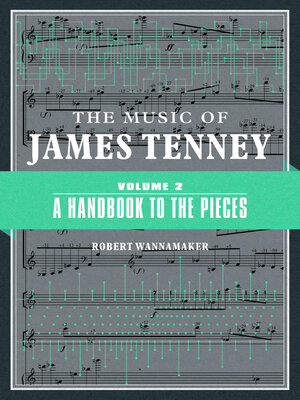
Sign up to save your library
With an OverDrive account, you can save your favorite libraries for at-a-glance information about availability. Find out more about OverDrive accounts.
Find this title in Libby, the library reading app by OverDrive.



Search for a digital library with this title
Title found at these libraries:
| Library Name | Distance |
|---|---|
| Loading... |
Robert Wannamaker's monumental two-volume study explores the influential music and ideas of American composer, theorist, writer, performer, and educator James Tenney. Delving into the whole of Tenney's far-ranging oeuvre, Wannamaker offers close, aurally grounded analyses of works linked to the artist's revolutionary theories of musical form, timbre, and harmonic perception.
Written as a reference work, Volume 2, A Handbook to the Pieces, presents detailed entries on Tenney's significant post-1959 experimental works (excepting pieces covered in volume 1). Wannamaker includes technical information, an analysis of intentions and goals, graphs and musical examples, historical and biographical context, and thoughts from Tenney and others on specific works. Throughout, he discusses the striking compositional ideas found in Tenney's music and, where appropriate, traces an idea's appearance from one piece to the next to reveal the evolution of the composer's art and thought.
A landmark in experimental music scholarship, The Music of James Tenney is a first-of-its-kind consideration of the experimental music titan and his work.
|Preface xiii
1. 1952–59 (Early Works) 1
1.1. Monody (1959) 3
2. 1959–61 (Tape Music) 7
2.1. Improvisations for Medea (1960) 7
2.2. Collage #1 ("Blue Suede") (1961) 8
3. 1961–64 (Computer Music) 9
3.1. Analog #1 (Noise Study) (1961) 9
3.2. Entrance/Exit Music (1962) 9
3.3. Five Stochastic Studies (1962) 13
3.4. Stochastic String Quartet (1963) and Stochastic Quartet (1963) 16
3.5. Dialogue (1963) 22
3.6. Radio Piece (1963) 27
3.7. Ergodos I (1963) 28
3.8. Phases (1963) 30
3.9. Music for Player Piano (1964) 30
3.10. Ergodos II (1964) 36
3.11. String Complement (1964) and Instrumental Responses (1964) 38
4. 1964–68 (Performance and the Social) 42
4.1. Choreogram (1964) 42
4.2. Chamber Music (1964) 42
4.3. Maximusic (1965) 47
4.4. Metabolic Music (1965) 47
4.5. Three Theater Pieces (1965) 49
4.6. Collage #2 ("Viet Flakes") (1966) 51
4.7. A House of Dust (1967) and Letters to Gertrude Stein (1968) 60
4.8. Fabric for Che (1967) 66
4.9. Swell Piece (1967) 66
5. 1969–73 (Process and Continuity) 67
5.1. For Ann (rising) (1969) 67
5.2. Quiet Fan for Erik Satie (1970/1971) 67
5.3. Hey When I Sing These 4 Songs Hey Look What Happens (1971) 74
5.4. Postal Pieces (1965–71) 75
5.5. For 12 Strings (rising) (1971) 97
5.6. In the . . . Mode (1971, 1973) 99
6. 1972–79 (Canons and the Harmonic Series) 103
6.1. Clang (1972) 103
6.2. Quintext: Five Textures (1972) 103
6.3. Canon (1973) 117
6.4. The Chorales Series (1973–75) 118
6.5. Spectral CANON for CONLON Nancarrow (1974) 124
6.6. Orchestral Study: The "Creation Field" (1974) 124
6.7. Three Harmonic Studies (1974) 126
6.8. Three Pieces for Mechanical Drum (1974–75) 134
6.9. Three Pieces for Drum Quartet (1974–75) 145
6.10. Symphony (1975) 160
6.11. Harmoniums #1, #4, and #5 (1976–78) 161
6.12. Saxony (1978) 169
6.13. Three Indigenous Songs (1979) 172
7. 1980–85 (Harmonic Spaces) 173
7.1. Harmoniums #2, #3, #6, and #7 (1980–2000) 173
7.2. Chromatic Canon (1980/1983) 178
7.3. Band (1980/1983) 190
7.4. Septet (1981) 193
7.5. Glissade (1982) 199
7.6. Two Koans and a Canon...







